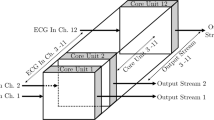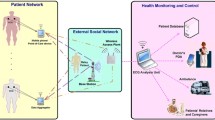Abstract
The most common non-invasive diagnostic model is the Electrocardiogram (ECG), which records the heart’s electrical activity over time and is used to diagnose various heart conditions. Due to the requirements of a typical eHealth system, it is necessary to compress ECG signals for long-term data recording and remote transmission. Moreover, cardiovascular diseases (CVDs) have been considered the most long-lasting disorders in recent years. The transmission of information from the patient to the distant hospital is necessary because rapid analysis and treatment are essential for the condition to be cured. Also, the data must be in the form of lossless and high-predictability data. So, the goal of this study was to create a two-stage lossless Integer Adaptive Predictor (IAP) compressor that could be implemented on a Field Programmable Gate Array (FPGA) without introducing any data loss during the compression process. Before compression, the ECG signals are denoised using a Fast Normalized Least Mean Square (FNLMS) algorithm-based adaptive filter, which removes the undesirable noise presented in the signal. Here, the adaptive filter is designed based on the hybrid systolic folding structure and compressor-based multiplier architecture to minimize the power, delay and area consumption of the filter while performing the signal-denoising process. Xilinx and MATLAB are used to run simulations using the MIT-BIH Arrhythmia and PTB diagnostic databases. Several performance parameters are used to assess the proposed design’s efficacy, and the results are compared to those of similar current designs. Consequently, the proposed compressor achieves a 45.23% compression ratio (CR) on MIT-BIH and a 10.87% average CR on the PTB diagnostic database, which demonstrates that the compression proficiency of the proposed design is high.
















Similar content being viewed by others
Data availability
Data sharing is not applicable to this article.
References
Lippi, G., Henry, B. M., & Sanchis-Gomar, F. (2020). Physical inactivity and cardiovascular disease at the time of coronavirus disease 2019 (COVID-19). European Journal of Preventive Cardiology, 27(9), 906–908.
Vogel, B., Acevedo, M., Appelman, Y., Merz, C. N., Chieffo, A., Figtree, G. A., Guerrero, M., Kunadian, V., Lam, C. S., Maas, A. H., & Mihailidou, A. S. (2021). The Lancet women and cardiovascular disease commission: Reducing the global burden by 2030. The Lancet, 397(10292), 2385–2438.
Jankowski, J., Floege, J., Fliser, D., Boehm, M., & Marx, N. (2021). Cardiovascular disease in chronic kidney disease: Pathophysiological insights and therapeutic options. Circulation, 143(11), 1157–1172.
Nurgalieva, L., O’Callaghan, D., & Doherty, G. (2020). Security and privacy of mHealth applications: A scoping review. IEEE Access, 4(8), 104247–104268.
Cuevas-González, D., García-Vázquez, J. P., Bravo-Zanoguera, M., López-Avitia, R., Reyna, M. A., Zermeño-Campos, N. A., & González-Ramírez, M. L. (2022). ECG standards and formats for Interoperability between mHealth and healthcare information systems: A Scoping review. International Journal of Environmental Research and Public Health, 19(19), 11941.
Zaman, M. S., & Morshed, B. I. (2021). A low-power portable scanner for body-worn wireless resistive analog passive (WRAP) sensors for mHealth applications. Measurement, 177, 109214.
Wasimuddin, M., Elleithy, K., Abuzneid, A. S., Faezipour, M., & Abuzaghleh, O. (2020). Stages-based ECG signal analysis from traditional signal processing to machine learning approaches: A survey. IEEE Access, 8, 177782–177803.
Ibtehaz, N., Rahman, M. S., & Rahman, M. S. (2019). VFPred: A fusion of signal processing and machine learning techniques in detecting ventricular fibrillation from ECG signals. Biomedical Signal Processing and Control, 49, 349–359.
Rajankar, S. O., & Talbar, S. N. (2019). an electrocardiogram signal compression techniques: A comprehensive review. Analog Integrated Circuits and Signal Processing, 98(1), 59–74.
Tiwari, A., & Falk, T. H. (2019). Lossless electrocardiogram signal compression: A review of existing methods. Biomedical Signal Processing and Control, 51, 338–346.
Pal, H. S., Kumar, A., Vishwakarma, A., & Ahirwal, M. K. (2022). Electrocardiogram signal compression using tunable-Q wavelet transform and meta-heuristic optimization techniques. Biomedical Signal Processing and Control, 78, 103932.
Singhai, P., Ateek, A., Kumar, A., Ansari, I.A., & Bhalerao, S. (2020). Ecg signal compression based on wavelet parameterization and thresholding using pso. In 2020 international conference on communication and signal processing (ICCSP), IEEE. Pp. 622–627.
Sanivarapu, P. V., Rajesh, K. N., Reddy, N. V., & Reddy, N. (2020). Patient data hiding into ECG signal using watermarking in transform domain. Physical and Engineering Sciences in Medicine, 43(1), 213–226.
Šaliga, J., Andráš, I., Dolinský, P., Michaeli, L., Kováč, O., & Kromka, J. (2021). ECG compressed sensing method with high compression ratio and dynamic model reconstruction. Measurement, 183, 109803.
Lee, D., Lee, S., & Park, D. (2021). FPGA-based cloudification of ECG signal diagnosis acceleration. In 2021 twelfth international conference on ubiquitous and future networks (ICUFN), IEEE. pp. 236–238.
Loganathan, S., & Sujatha, C. M. (2022). Hardware implementation of ECG signal compression using SPIHT. In Journal of physics: Conference series, IOP Publishing vol. 2318, No. (1), p. 012017.
Sevak, M. M., & Pawar, T. D. (2022). ECG signal compression using singular value decomposition and implementation on PYNQ-Z2. In ICT systems and sustainability, Springer, Singapore pp. 837–849.
Sarma, J., & Biswas, R. (2022). A VLSI-based hybrid ECG compression scheme for wearable sensor node. IEEE Sensors Letters, 6(4), 1–4.
Aruna, V. B., Ekambaram, C., & Padmaja, M. (2023). Field programmable gate array implementation of an adaptive filtering based noise reduction and enhanced compression technique for healthcare applications. Transactions on Emerging Telecommunications Technologies, 34, e4654.
Muneendra, D., Jhansi, G., Lokesh, V. R., Hemanth, M., Harshitha, S., & Madhava, M. Multi-channel ECG lossless compression system.
Manga, N.A., Pradeep Kumar, G., & Satyanarayana Tallapragada, V. (2022). FPGA design of arithmetic optimized APT-VDF using reusable Vedic multiplier with simplified combinational logics for medical signal denoising. International Journal of Electronics, 1–22.
Tsai, T. H., & Tsai, F. L. (2020). Efficient lossless compression scheme for multi-channel ECG signal processing. Biomedical Signal Processing and Control., 59, 101879.
Ez-ziymy, S., Hatim, A., & Hammia, S. (2023). Real-time hardware architecture of an ECG compression algorithm for IoT health care systems and its VLSI implementation. Multimedia Tools and Applications. 1–25.
Baskar, V. V., Sivakumar, V. G., Vimal, S. P., Vadivel, M., & Selvi, C. (2023). FPGA implementation of novel lossless ECG compression algorithm for low power devices. In 2023 4th international conference on electronics and sustainable communication systems (ICESC) IEEE. pp. 38–41.
Habibi, Z., Karimizadeh, K., Nosratpour, A., & Alenizi, F. A. A method for Qrs detection and Ecg compression based on improved adaptive threshold in real time.
Pal, H. S., Kumar, A., Vishwakarma, A., & Lee, H. N. (2023). Electrocardiogram signal compression using adaptive tunable-Q wavelet transform and modified dead-zone quantizer. ISA Transactions, 142(335), 346.
Chen, Q., Wu, W., Zheng, H., Zhao, B., Ma, Z., & Chen, W. (2022). Stream-based lossless compression of sensor signals using an integer adaptive predictor. IEEE Transactions on Circuits and Systems II: Express Briefs, 69(12), 5194–5198.
Khalaf, A. J., & Mohammed, S. J. (2021). Verification and comparison of MIT-BIH arrhythmia database based on number of beats. International Journal of Electrical and Computer Engineering, 11(6), 4950.
Sadhukhan, D., Pal, S., & Mitra, M. (2015). Electrocardiogram data compression using adaptive bit encoding of the discrete Fourier transforms coefficients. IET Science, Measurement & Technology, 9(7), 866–874.
Yildirim, O., Tan, R. S., & Acharya, U. R. (2018). An efficient compression of ECG signals using deep convolutional auto encoders. Cognitive Systems Research, 52, 198–211.
Chandra, S., Sharma, A., & Kumar Singh, G. (2020). Computationally efficient cosine modulated filter bank design for ECG signal compression. IRBM, 41(1), 2–17.
Tsai, T. H., Tung, N. C., & Lin, D. B. (2021). VLSI implementation of multi-channel ECG lossless compression system. IEEE Transactions on Circuits and Systems II: Express Briefs, 68(8), 2962–2966.
Tseng, Y. H., Chen, Y. H., & Lu, C. W. (2017). Adaptive integration of the compressed algorithm of CS and NPC for the ECG signal compressed algorithm in VLSI implementation. Sensors, 17(10), 2288.
Chowdhury, H. M., & Cheung, R. C. C. (2019). Reconfigurable architecture for multi-lead ECG signal compression with high-frequency noise reduction. Scientific Reports, 9(1), 1–12.
Venkatesan, C., Karthigaikumar, P., & Varatharajan, R. (2019). FPGA implementation of modified error normalized LMS adaptive filter for ECG noise removal. Cluster Computing, 22(5), 12233–12241.
Ganatra, M. M., & Chandresh, H. V. (2022). FPGA design of a variable step-size variable tap length denlms filter with hybrid systolic-folding structure and compressor-based booth multiplier for noise reduction in Ecg signal. Circuits, Systems, and Signal Processing, 41(6), 3592–3622.
Kerdjidj, O., Amira, A., Ghanem, K., Ramzan, N., Katsigiannis, S., & Chouireb, F. (2019). An FPGA implementation of the matching pursuit algorithm for a compressed sensing enabled e-Health monitoring platform. Microprocessors and Microsystems, 67, 131–139.
Xia, Y., Chen, C., Shu, M., & Liu, R. (2023). A denoising method of ECG signal based on variational autoencoder and masked convolution. Journal of Electrocardiology., 80, 81–90.
Funding
No funding is provided for the preparation of the manuscript.
Author information
Authors and Affiliations
Contributions
All authors have equal contributions in this work.
Corresponding author
Ethics declarations
Conflict of interest
Authors declare that they have no conflict of interest.
Ethical approval
This article does not contain any studies with human participants or animals performed by any of the authors.
Consent to participate
All the authors involved have agreed to participate in this submitted article.
Consent to publish
All the authors involved in this manuscript give full consent for publication of this submitted article.
Additional information
Publisher's Note
Springer Nature remains neutral with regard to jurisdictional claims in published maps and institutional affiliations.
Rights and permissions
Springer Nature or its licensor (e.g. a society or other partner) holds exclusive rights to this article under a publishing agreement with the author(s) or other rightsholder(s); author self-archiving of the accepted manuscript version of this article is solely governed by the terms of such publishing agreement and applicable law.
About this article
Cite this article
Reddy, P.V., Tallapragada, V.V.S. FPGA-enabled lossless ECG signal compression system using an integer adaptive compressor. Analog Integr Circ Sig Process 119, 331–361 (2024). https://doi.org/10.1007/s10470-024-02269-w
Received:
Revised:
Accepted:
Published:
Issue Date:
DOI: https://doi.org/10.1007/s10470-024-02269-w




